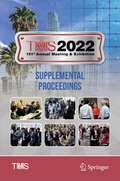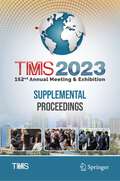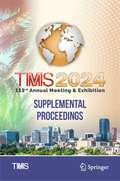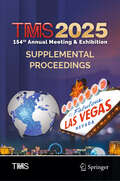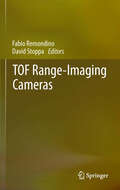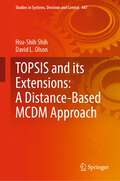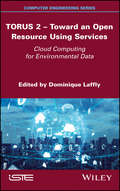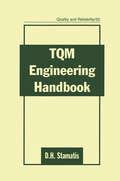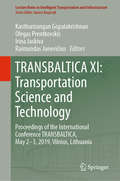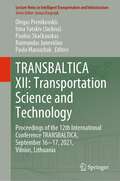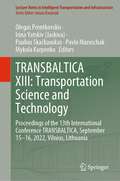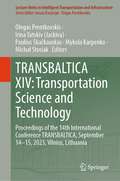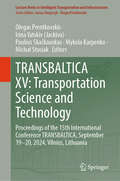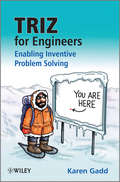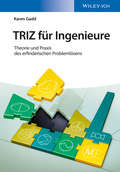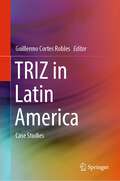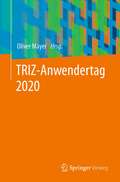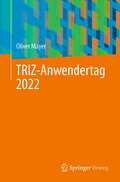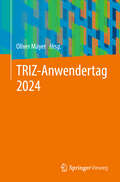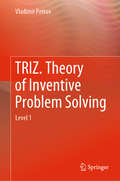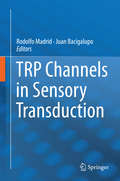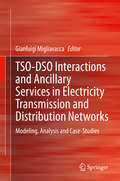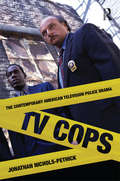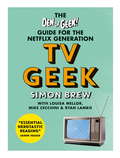- Table View
- List View
TMS 2022 151st Annual Meeting & Exhibition Supplemental Proceedings (The Minerals, Metals & Materials Series)
by The Minerals, Metals & Materials SocietyThis collection presents papers from the 151st Annual Meeting & Exhibition of The Minerals, Metals & Materials Society.
TMS 2023 152nd Annual Meeting & Exhibition Supplemental Proceedings (The Minerals, Metals & Materials Series)
by The Minerals, Metals & Materials SocietyThis collection presents papers from the 152nd Annual Meeting & Exhibition of The Minerals, Metals & Materials Society.
TMS 2024 153rd Annual Meeting & Exhibition Supplemental Proceedings (The Minerals, Metals & Materials Series)
by The Minerals, Metals & Materials SocietyThis collection presents papers from the 153rd Annual Meeting & Exhibition of The Minerals, Metals & Materials Society.
TMS 2025 154th Annual Meeting & Exhibition Supplemental Proceedings (The Minerals, Metals & Materials Series)
by The Minerals, Metals & Materials SocietyThis collection presents papers from the 154th Annual Meeting & Exhibition of The Minerals, Metals & Materials Society.
TOF Range-Imaging Cameras
by David Stoppa Fabio RemondinoToday the cost of solid-state two-dimensional imagers has dramatically dropped, introducing low cost systems on the market suitable for a variety of applications, including both industrial and consumer products. However, these systems can capture only a two-dimensional projection (2D), or intensity map, of the scene under observation, losing a variable of paramount importance, i.e., the arrival time of the impinging photons. Time-Of-Flight (TOF) Range-Imaging (TOF) is an emerging sensor technology able to deliver, at the same time, depth and intensity maps of the scene under observation. Featuring different sensor resolutions, RIM cameras serve a wide community with a lot of applications like monitoring, architecture, life sciences, robotics, etc. This book will bring together experts from the sensor and metrology side in order to collect the state-of-art researchers in these fields working with RIM cameras. All the aspects in the acquisition and processing chain will be addressed, from recent updates concerning the photo-detectors, to the analysis of the calibration techniques, giving also a perspective onto new applications domains.
TOPSIS and its Extensions: A Distance-Based MCDM Approach (Studies in Systems, Decision and Control #447)
by David L. Olson Hsu-Shih ShihThe objective of the book is to provide materials to demonstrate the development of TOPSIS and to serve as a handbook. It contains the basic process of TOPSIS, numerous variant processes, property explanations, theoretical developments, and illustrative examples with real-world cases. Possible readers would be graduate students, researchers, analysts, and professionals who are interested in TOPSIS, a distance-based algorithm, and who would like to compare TOPSIS with other MCDM methods. The book serves as a research reference as well as a self-learning book with step-by-step illustrations for the MCDM community.
TORUS 2 - Toward an Open Resource Using Services: Cloud Computing for Environmental Data
by Dominique LafflyThis book, presented in three volumes, examines "environmental" disciplines in relation to major players in contemporary science: Big Data, artificial intelligence and cloud computing. Today, there is a real sense of urgency regarding the evolution of computer technology, the ever-increasing volume of data, threats to our climate and the sustainable development of our planet. As such, we need to reduce technology just as much as we need to bridge the global socio-economic gap between the North and South; between universal free access to data (open data) and free software (open source). In this book, we pay particular attention to certain environmental subjects, in order to enrich our understanding of cloud computing. These subjects are: erosion; urban air pollution and atmospheric pollution in Southeast Asia; melting permafrost (causing the accelerated release of soil organic carbon in the atmosphere); alert systems of environmental hazards (such as forest fires, prospective modeling of socio-spatial practices and land use); and web fountains of geographical data. Finally, this book asks the question: in order to find a pattern in the data, how do we move from a traditional computing model-based world to pure mathematical research? After thorough examination of this topic, we conclude that this goal is both transdisciplinary and achievable.
TQM Engineering Handbook (Quality and Reliability)
by D.H. StamatisOffering a model, an implementing strategy, as well as traditional and nontraditional methods for the successful enhancement and maintenance of quality, this work establishes a rationale for the continuation of Total Quality Management (TQM) in all organizations. It considers leading quality-related topics, such as unusual charts, supplier-organiza
TRANSBALTICA XI: Proceedings of the International Conference TRANSBALTICA, May 2-3, 2019, Vilnius, Lithuania (Lecture Notes in Intelligent Transportation and Infrastructure)
by Kasthurirangan Gopalakrishnan Olegas Prentkovskis Irina Jackiva Raimundas JunevičiusThis book gathers papers presented at the 11th international scientific conference "Transbaltica: Transportation Science and Technology", held on May 2-3, 2019 at Vilnius Gediminas Technical University, Lithuania. It covers cutting-edge issues concerning research and development of modern transport systems. The chapters, written by an international group of experts, discuss novel and smart solutions in the area of vehicle engineering, including environmentally friendly technologies, topics relating to traffic safety, modeling and control, and solutions and challenges in modern logistics. Further topics include multimodal transport and vehicle automation. Providing comprehensive information and ideas concerning innovative transportation technologies and challenges, this book offers a valuable resource for transportation researchers and practitioners, including engineers, managers and decision-makers in the field.
TRANSBALTICA XII: Proceedings of the 12th International Conference TRANSBALTICA, September 16-17, 2021, Vilnius, Lithuania (Lecture Notes in Intelligent Transportation and Infrastructure)
by Irina Yatskiv Olegas Prentkovskis Raimundas Junevičius Paulius Skačkauskas Pavlo MaruschakThis book reports on innovative research and developments in the broad field of transportation. It covers solutions relating to intelligent vehicles and infrastructure, energy and combustion management, vehicle dynamics and control, as well as research on human factors, logistics and security. Contributions are based on peer-reviewed papers presented at the 12th international scientific conference "Transbaltica: Transportation Science and Technology", held virtually from Vilnius Gediminas Technical University, Lithuania, on September 16-17, 2021. All in all, this book offers extensive information on modern transport systems, with a good balance of theory and practice.
TRANSBALTICA XIII: Proceedings of the 13th International Conference TRANSBALTICA, September 15-16, 2022, Vilnius, Lithuania (Lecture Notes in Intelligent Transportation and Infrastructure)
by Irina Yatskiv Olegas Prentkovskis Paulius Skačkauskas Pavlo Maruschak Mykola KarpenkoThis book reports on innovative research and developments in the broad field of transportation. It covers solutions relating to intelligent vehicles and infrastructure, energy and combustion management, vehicle dynamics and engineering, as well as research on railway transport, aerospace technologies, logistics and security. Contributions are based on peer-reviewed papers presented at the 13th international scientific conference "Transbaltica: Transportation Science and Technology", held on September 15-16, 2022, at Vilnius Gediminas Technical University, in Vilnius, Lithuania. All in all, this book offers extensive information on modern transport systems, with a good balance of theory and practice.
TRANSBALTICA XIV: Proceedings of the 14th International Conference TRANSBALTICA, September 14-15, 2023, Vilnius, Lithuania (Lecture Notes in Intelligent Transportation and Infrastructure)
by Irina Yatskiv Olegas Prentkovskis Paulius Skačkauskas Mykola Karpenko Michał StosiakThis book reports on innovative research and developments in the broad field of transportation. It covers innovative solutions relating to intelligent vehicles and infrastructure, energy and combustion management, vehicle dynamics and engineering. It also reports on advances in railway transport, air transportation, as well as transportation safety and logistics. Chapters are based on peer-reviewed papers presented at the 14th international scientific conference "Transbaltica: Transportation Science and Technology", held on September 14-15, 2023, at Vilnius Gediminas Technical University, in Vilnius, Lithuania. All in all, this book offers extensive and timely information to both researchers and practitioners in the field of transportation, logistics and related interdisciplinary areas.
TRANSBALTICA XV: Proceedings of the 15th International Conference TRANSBALTICA, September 19–20, 2024, Vilnius, Lithuania (Lecture Notes in Intelligent Transportation and Infrastructure)
by Irina Yatskiv Olegas Prentkovskis Paulius Skačkauskas Mykola Karpenko Michał StosiakThis book reports on innovative research and developments in the broad field of transportation. It covers innovative solutions relating to intelligent vehicles and infrastructure, energy and combustion management, vehicle dynamics and engineering. It also reports on advances in railway transport, air transportation, as well as transportation safety and logistics. Chapters are based on peer-reviewed papers presented at the 15th international scientific conference "Transbaltica: Transportation Science and Technology", held on September 19–20, 2024, in person at Vilnius Gediminas Technical University, in Vilnius, Lithuania, and also online. All in all, this book offers extensive and timely information to both researchers and practitioners in the field of transportation, logistics and related interdisciplinary areas.
TRIZ for Engineers: Enabling Inventive Problem Solving
by Clive Goddard Karen GaddTRIZ is a brilliant toolkit for nurturing engineering creativity and innovation. This accessible, colourful and practical guide has been developed from problem-solving workshops run by Oxford Creativity, one of the world's top TRIZ training organizations started by Gadd in 1998. Gadd has successfully introduced TRIZ to many major organisations such as Airbus, Sellafield Sites, Saint-Gobain, DCA, Doosan Babcock, Kraft, Qinetiq, Trelleborg, Rolls Royce and BAE Systems, working on diverse major projects including next generation submarines, chocolate packaging, nuclear clean-up, sustainability and cost reduction.Engineering companies are increasingly recognising and acting upon the need to encourage successful, practical and systematic innovation at every stage of the engineering process including product development and design. TRIZ enables greater clarity of thought and taps into the creativity innate in all of us, transforming random, ineffective brainstorming into targeted, audited, creative sessions focussed on the problem at hand and unlocking the engineers' knowledge and genius to identify all the relevant solutions.For good design engineers and technical directors across all industries, as well as students of engineering, entrepreneurship and innovation, TRIZ for Engineers will help unlock and realise the potential of TRIZ. The individual tools are straightforward, the problem-solving process is systematic and repeatable, and the results will speak for themselves.This highly innovative book:Satisfies the need for concise, clearly presented information together with practical advice on TRIZ and problem solving algorithmsEmploys explanatory techniques, processes and examples that have been used to train thousands of engineers to use TRIZ successfullyContains real, relevant and recent case studies from major blue chip companiesIs illustrated throughout with specially commissioned full-colour cartoons that illustrate the various concepts and techniques and bring the theory to lifeTurns good engineers into great engineers.
TRIZ für Ingenieure: Theorie und Praxis des erfinderischen Problemlösens
by Karen GaddTRIZ, sinngema? ubersetzt als Theorie des erfinderischen Problemlosens, ist eine machtige Methode, um aus dem Erfahrungsschatz fruherer Erkenntnisse aktuelle Probleme zu verstehen und zielgerichtet zu losen, mit denen Ingenieure in ihrer taglichen Arbeit konfrontiert sind, sei es bei der Entwicklung neuer oder bei der Verbesserung bestehender Produkte. Es gibt viele Ansatze zur Analyse von Problemen und zur Definition der Anforderungen an eine Losung; TRIZ vereint diese Ansatze konzeptionell und gibt daruber hinaus, im Gegensatz zu anderen Methoden, Ingenieursteams Werkzeuge an die Hand, mit denen - systematisch - Losungen fur gegebene Fragestellungen gefunden werden konnen. Damit ist TRIZ das Mittel der Wahl, um in Unternehmen und Forschungseinrichtungen Kreativitat und Innovationskraft zu fordern. Dieser leicht zugangliche Praxisfuhrer in die Welt von TRIZ entstand aus der langjahrigen Schulungs- und Beratungserfahrung der Autorin Karen Gadd. Auf einzigartig verstandliche und unterhaltsame Weise, unterstutzt durch speziell fur dieses Buch erstellte Illustrationen und Cartoons, gelingt es Karen Gadd, den Leserinnen und Lesern die TRIZ-Methode nahezubringen, so dass sie diese in der Praxis einsetzen konnen. Dabei werden die abstrakten Ansatze wie die Widerspruchsmatrix, Ressourcen-Checklisten und das Prinzip der Idealitat stets mit konkreten Beispielen und Fallstudien aus der Praxis untermauert.
TRIZ in Latin America: Case Studies
by Guillermo Cortes RoblesThis book describes the adoption process of TRIZ under challenging conditions and under serious limitations. It presents the integration of TRIZ with other techniques to solve problems in the Latin America industry. The chapters contain some industrial cases that explain the adoption process of TRIZ. They also describe the restrictions or limits on the use and adoption of TRIZ. This book describes a strategy to apply the TRIZ tools for product or service design. Case studies from different universities and enterprises are presented to facilitate the assimilation of the TRIZ concepts and tools.
TRIZ-Anwendertag 2020
by Oliver MayerTRIZ is a valuable tool for inventive problem solving. Based on patent analysis TRIZ enables the faster solution-oriented generation of ideas in fields of technology, organizations, and software. Still TRIZ is not the only way that leads to innovation. There are more tools and each of them has its own pros and cons. Combining them is the key to success. The 1st TRIZ online conference by Bayern Innovativ was born from the TRIZ-Anwendertage. The idea behind is providing a platform that allows to discuss and display TRIZ development in the context of innovation methodology. This book presents papers in German and English language on how TRIZ is related to other tools like Design Thinking, the St. Gallen Business models, etc.
TRIZ-Anwendertag 2022
by Oliver MayerTRIZ is a valuable tool for inventive problem solving. Based on patent analysis TRIZ enables the faster solution-oriented generation of ideas in fields of technology, organizations, and software. TRIZ originated from mainly mechanical problems. But it can be applied very successfully as well for other branches like business, or sustainability or in traffic planning. This enlarged application range offers supplementary value of the tool box TRIZ. The 2nd TRIZ online conference by Bayern Innovativ was born from the TRIZ-Anwendertage. The idea behind is providing a platform that allows to discuss and display TRIZ development in the context of innovation methodology. This book presents papers in English & German language on how TRIZ is related to other tools like Design Thinking, the St. Gallen Business models, etc. and to different areas of application, not only electro-mechanical.
TRIZ-Anwendertag 2024
by Oliver MayerTRIZ is a valuable tool for inventive problem solving. Based on patent analysis TRIZ enables the faster solution-oriented generation of ideas in fields of technology, organizations, and software. TRIZ originated from mainly mechanical problems. But it can be applied very successfully as well for other branches like business, sustainability, with Artificial Intelligence (AI). This enlarged application range offers supplementary value of the toolbox TRIZ. The 3rd TRIZ online conference by Bayern Innovativ was born from the TRIZ-Anwendertage. The idea behind is providing a platform that allows to discuss and display TRIZ development in the context of innovation methodology. This book presents papers in English and German language according to the motto “TRIZ beyond tomorrow: actual trends and visions for the future“. At the TRIZ Conference online, the focus is on new applications, research and extensions of the TRIZ methodology. It is mainly attended by companies, research institutions, colleges, universities and aspirants for TRIZ L4 and L5 who are further developing TRIZ or combining it with other methods and in other areas such as quality assurance, business models, sustainability issues, etc.
TRIZ. Theory of Inventive Problem Solving: Level 1
by Vladimir PetrovThis introductory book describes the initial (first) level of studying the theory of inventive problem solving (TRIZ) from the series “TRIZ from A to Z,” and presents the most general methods for solving inventive problems and generating new ideas. Chapter 1 examines traditional technologies for problem solving, based on trial and error. Chapter 2 describes the general concept of TRIZ, while Chapter 3 explains the main notions of “system” approaches, like system thinking, system and its hierarchy, system effect, emergency, synergetic effect and systematicity. In turn, Chapter 4 describes the notion of “ideality” and Chapter 5 addresses the notion of resources, their types, and methods for using them. Chapter 6 acquaints readers with one of the most important aspects of TRIZ: contradiction. Chapter 7 describes the inventive principles, while Chapter 8 includes descriptions of the systems of trends proposed by G. Altshuller and the author. In closing, the author makes recommendations on how to most effectively use TRIZ tools, on how readers can improve their knowledge, skills and habits concerning the use of TRIZ, and on how they can hone their inventive thinking skills. The book also features Appendices that include analyses of selected problems, a list of the main websites related to TRIZ, and lists of examples, problems, illustrations, tables and formulae.
TRP Channels in Sensory Transduction
by Rodolfo Madrid Juan BacigalupoTRP channels play a key role in sensory physiology and have been the focus of intensive investigation in recent years. The proposed book will be a comprehensive, detailed overview of the ways in which TRP channels are involved in a wide variety of sensory modalities. Authors will explore the involvement of TRP channels in photo transduction (sight), chemotransduction (taste and odor), mechanotransduction (touch and hearing), thermo transduction (the sensation of temperature) and pain perception. Furthermore, the book will include some grounding chapters such as one on the history of TRP channel research, one on the biophysical characteristics of the proteins and one on trafficking and post-translational regulation.
TSO-DSO Interactions and Ancillary Services in Electricity Transmission and Distribution Networks: Modeling, Analysis and Case-Studies
by Gianluigi MigliavaccaThis book presents new and practical solutions to solve the coordination problem faced due to the increasing integration of renewable energy sources into existing electricity transmission networks it addresses how the subsequent technological revolution is not only affecting the structure of the electricity markets, but also the interactions between transmission system operators (TSO) and distribution system operators (DSO). A must-have for smart grid analysis, this book presents models and scenario buildups of complex systems and incorporates the experience of three technological pilots that are analyzing special issues connected to network monitoring and control, and participation to a would-be ancillary services market from special subjects. The reader will benefit from the experience drawn from SmartNet, a major research project encompassing 22 partners from nine EU countries and including input gathered from a significant number of industrial partners.
TV Cops: The Contemporary American Television Police Drama
by Jonathan Nichols-PethickThe police drama has been one of the longest running and most popular genres in American television. In TV Cops, Jonathan Nichols-Pethick argues that, perhaps more than any other genre, the police series in all its manifestations—from Hill Street Blues to Miami Vice to The Wire—embodies the full range of the cultural dynamics of television. Exploring the textual, industrial, and social contexts of police shows on American television, this book demonstrates how polices drama play a vital role in the way we understand and engage issues of social order that most of us otherwise experience only in such abstractions as laws and crime statistics. And given the current diffusion and popularity of the form, we might ask a number of questions that deserve serious critical attention: Under what circumstances have stories about the police proliferated in popular culture? What function do these stories serve for both the television industry and its audiences? Why have these stories become so commercially viable for the television industry in particular? How do stories about the police help us understand current social and political debates about crime, about the communities we live in, and about our identities as citizens?
TV Geek: The Den of Geek Guide for the Netflix Generation
by Simon BrewEssential nerdtastic reading! - Jason IssacsFrom the author of Den of Geek, this is the ultimate, nerdy television guide for TV geeks everywhere!TV Geek recounts the fascinating stories of cult-classic series, reveals the nerdy Easter eggs hidden in TV show sets, and demonstrates the awe-inspiring power of fandom, which has even been known to raise TV series from the dead. Includes:- How the live-action Star Wars TV show fell apart- The logistics and history of the crossover episode- The underrated geeky TV shows of the 1980s- The hidden details of Game of Thrones- Five Scandinavian crime thrillers that became binge hits - The Walking Dead, and the power of fandomTV series are now as big as Hollywood movies with their big budgets, massive stars, and ever-growing audience figures! TV Geek provides an insightful look at the fascinating history, facts and anecdotes behind the greatest (and not-so-great) shows.
TV Geek: The Den of Geek Guide for the Netflix Generation
by Simon BrewTV Geek recounts the fascinating stories of cult-classic series, reveals the nerdy Easter eggs hidden in TV show sets, and demonstrates the awe-inspiring power of fandom, which has even been known to raise TV series from the dead. Subjects include:- How the live-action Star Wars TV show fell apart- The logistics and history of the crossover episode- The underrated geeky TV shows of the 1980s- The hidden details of Game of Thrones- Five Scandinavian crime thrillers that became binge hits - The Walking Dead, and the power of fandomTV series now have the same budgets, stars, audience figures and cultural impact as Hollywood movies, and TV Geek provides an insightful look at the fascinating history, facts and anecdotes behind the greatest (and not-so-great) shows.This is the ultimate, nerdy television guide for TV geeks everywhere.
